As queer art becomes more mainstream, a group of young talents finds itself at the center of a larger cultural conversation.
A sideways glance, the locking of eyes, a wink. Historically, that was the queer gaze: furtive, coded, clandestine.
And now? In shows that sell out before they open, paintings by a group of emerging artists in New York have pulled back the curtain to let the public stare openly at queer carnality and domesticity. Same-sex intimacy no longer feels transgressive; it’s at the center of art world conversations. “The question is, will I sell the big landscape I made?” said Doron Langberg, 36, who is known for scrutinizing the male body as sensuously as Delacroix or Courbet depicted the female nude. “Because there is a movement in the art world to support queer content, something like a landscape might not sell.”

Michael Stamm, Gay Dead Satan, 2020. Oil and acrylic on canvas wrapped panel with artist’s frame, 42 x 32 inches.
At various Chelsea galleries last fall, Jenna Gribbon, 42, exhibited canvases nearly seven feet high of her nude blonde partner, as seen through the artist’s parted naked legs. Justin Liam O’Brien, 30, depicted his husband eyeing a man being orally and anally penetrated at a sex party. Anthony Cudahy, 32, showed scenes of gay men, including his husband, relaxing in cozy familiarity and casual states of undress. This loosely connected group of artists attend one another’s openings and discuss their work on studio visits. Some go out dancing together and meet up on Fire Island. “It’s amazing to feel that I’m part of a community,” Gribbon said, noting that she has met many of her cohorts via a DM on Instagram. “Finding friends has been easier in this age of social media.”

Doron Langberg in his Queens studio. Photographed by Tommy Kha.
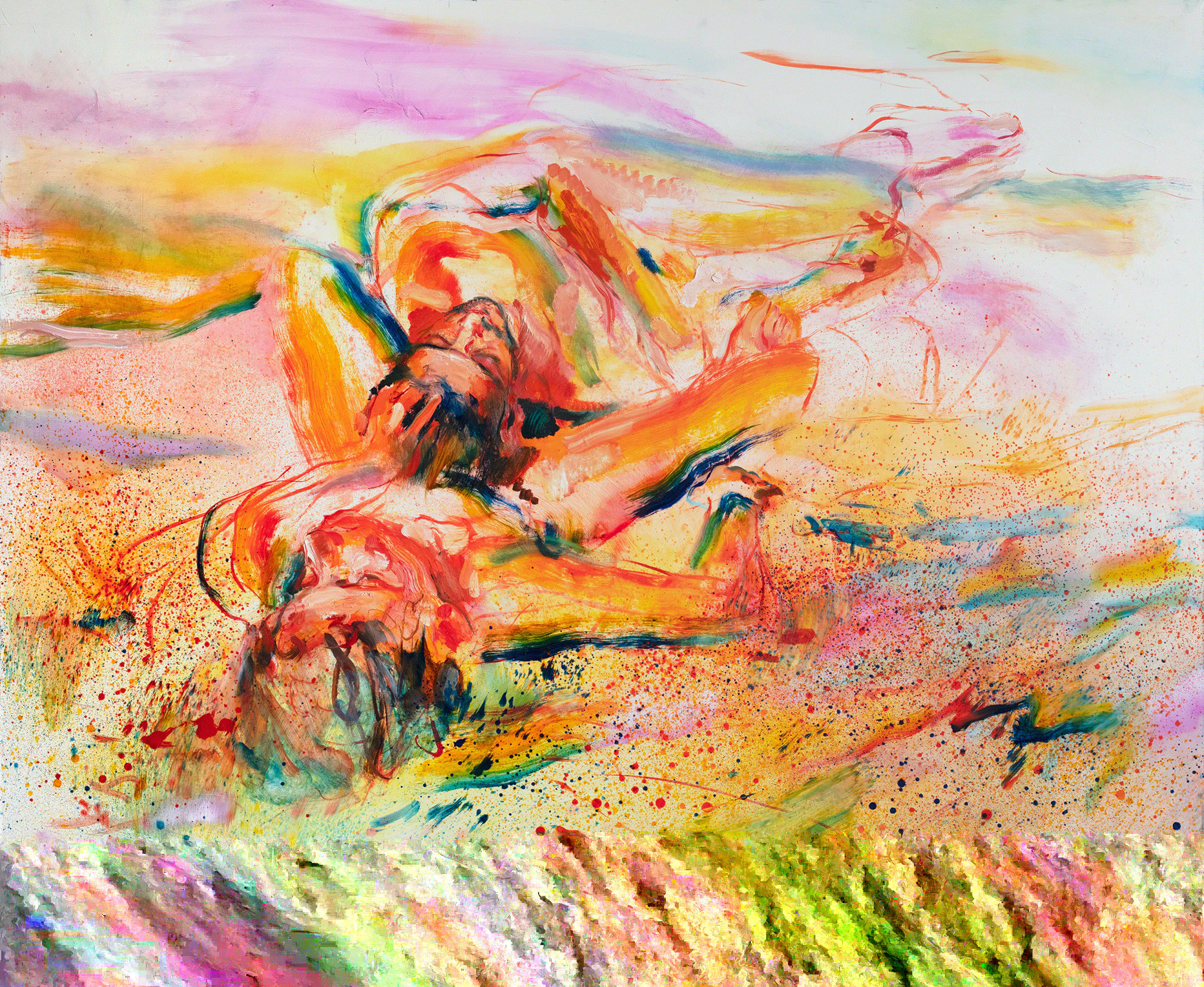
Langberg’s In My Lap, 2021. © Doron Langberg, courtesy of the artist and Victoria Miro.
In parallel with their success in commercial venues, these painters are being heralded by museums. Salman Toor, 38, who had a solo show at the Whitney Museum of American Art last year, is preparing for exhibitions at M Woods, in Beijing, in April, and at the Baltimore Museum of Art, in May. In a show of eight young figurative artists that opens at the end of March, the Institute of Contemporary Art Boston will feature three queer New York painters: Ambera Wellmann, Louis Fratino, and Langberg. And, most remarkably, the Frick Collection is elevating young queer artists to celestial heights in a yearlong project, “Living Histories: Queer Views and Old Masters,” in which Gribbon, Toor, Langberg, and Toyin Ojih Odutola each present a painting made in response to a masterpiece by Vermeer, Rembrandt, or Holbein.
As appreciative as they are to be making a living from their art, many of these politically progressive talents view their collective conquest warily. If your shows sell out, does that make you a sellout? “Pleasure and the depiction of pleasure is necessary,” said Michael Stamm, 38, who had his own solo exhibition this year at Shulamit Nazarian in Los Angeles. “I just worry that the cultural freedoms that we are enjoying are the Trojan horse for the proliferation of capitalism—that queer intimacy is becoming more of a commodity.” 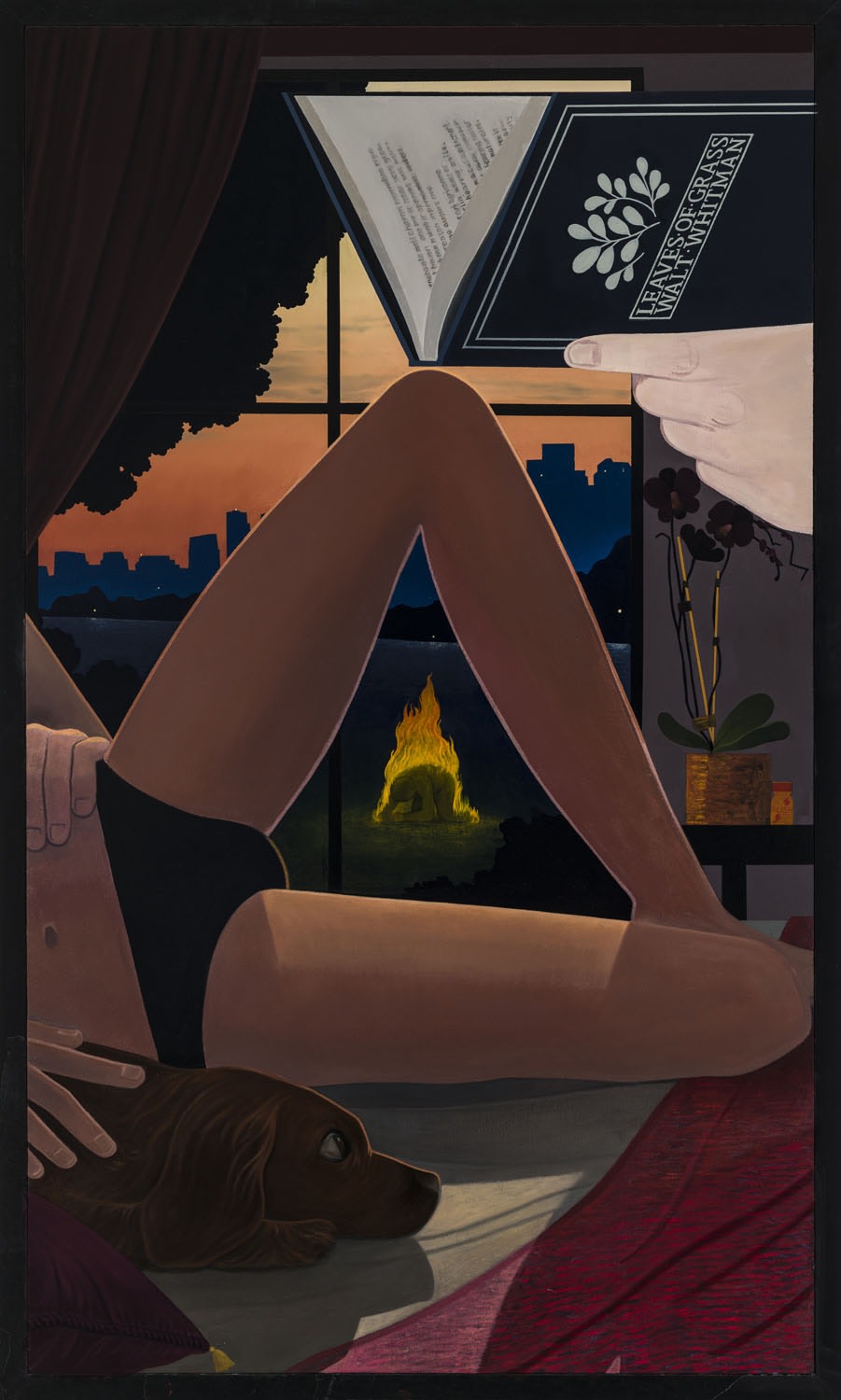
Michael Stamm, April 14, 2018 (RIP David Buckel), 2020. Oil and acrylic on canvas wrapped panel with artist’s frame. 50 x 30 inches.
In one painting in the L.A. show, he portrayed a pair of postcoital lovers reading Walt Whitman (cultural privilege), with a bottle of poppers (sexual license) and a potted orchid (bourgeois luxury) on a table, oblivious to a tragedy that is occurring outside their window: the self-immolation of David Buckel, a prominent gay-rights lawyer and environmental activist who killed himself in Brooklyn’s Prospect Park, in 2018, as a protest against fossil fuel consumption. “I’m selling all my paintings,” Stamm said, “but I’m trying to make them a little less digestible to justify it to myself.”
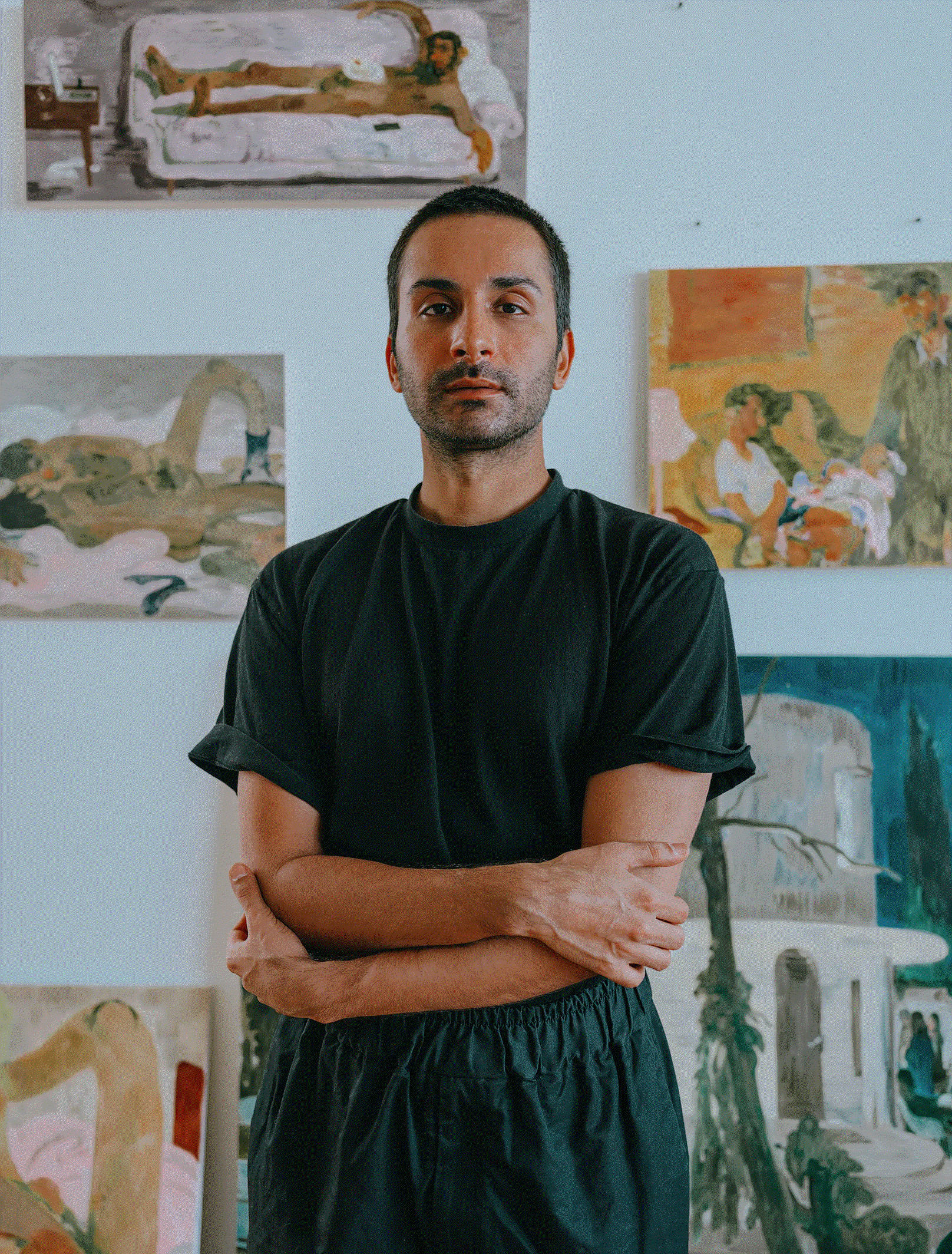
Salman Toor in his Brooklyn studio. Photographed by Jack Pierson.
One of the strengths of this flowering of queer art is its variety. Unlike some of his peers, Stamm shies away from explicit evocations of sex. He paints sharp-edged, stylized, and exaggerated figures in smooth acrylics, often adding a layer of laser-cut wood veneer over the surface. Kyle Dunn, 31, also depicts figures (sometimes in bas-relief) that aren’t lifelike but seem, instead, with their articulated and simplified bodies, to emerge from the digitally rendered realm of animation, video games, or fantasy. And while his men might be naked, they are not engaged in sex. “I’m certainly not a prude, but I like the titillation maybe more than the dick and ass,” Dunn said. “Courtship is as erotic as actual sex. For my own work, painting is where you can explore fantasy and desire, and things that aren’t there to look at.”
Michael Stamm, Submission, 2020. Oil, acrylic and oil stick on canvas with artist’s frame, 30 x 23 inches.
On the other hand, Langberg luxuriates in thick, voluptuous brushwork in oil paintings that often graphically depict gay sex, including acts that some viewers might find eye-opening. “I love painting rimming scenes, because there is still something subversive about it,” he said. “But I don’t make my explicit work to be shocking. This is how I experience sexuality; it’s not aimed at the pearl-clutchers.” He also likes to portray undressed men from their waist to their upper thighs, in what he calls “dick portraits.” However loaded the subject matter, he succeeds at generating his charge not through X-rated content, but by his handling of the paint. “They’re all made from observation,” Langberg said of the dick portraits. “I try to be led by my own desire, and I want that process to be evident on the surface—some areas fast, some slow, some with more information. That level of specificity directs the viewer in a way that recognizes this desire.”

Ambera Wellmann, Yurning, 2019. Courtesy of the artist, Company Gallery, New York, and K-T-Z, Berlin.

Wellmann in her Brooklyn studio. Photographed by Tommy Kha.
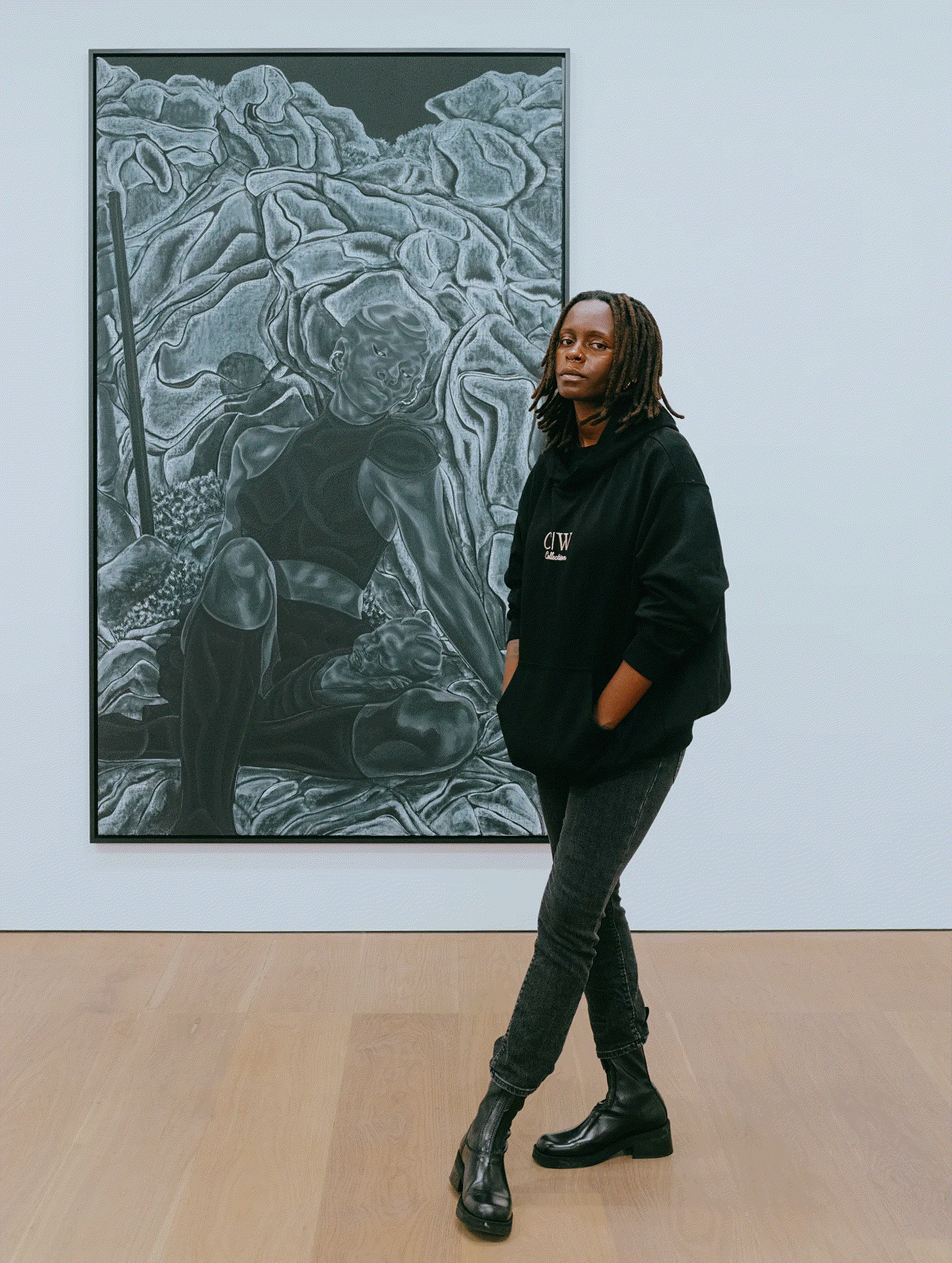
Toyin Ojih Odutola with 'New Found Land; A Vow,' 2020, at Jack Shainman Gallery. Photographed by Tommy Kha.
Gribbon had been living in Long Island City with her male partner and their child, working in a basement studio on what she describes as “cerebral diagram paintings with symbols.” Although their open relationship meant she could date women, she felt alienated, and that feeling surfaced in her work. “Everything tended to be kind of obscured, the way I was obscured,” she said. “The figures were fragmented or superimposed into spaces where they didn’t belong. I was living this life that didn’t feel like it was my life, or like the life I was supposed to be living. When things clicked into place and I started living with a woman exclusively, the painting was so much less of a struggle. Things were less fragmented and collage-y.”
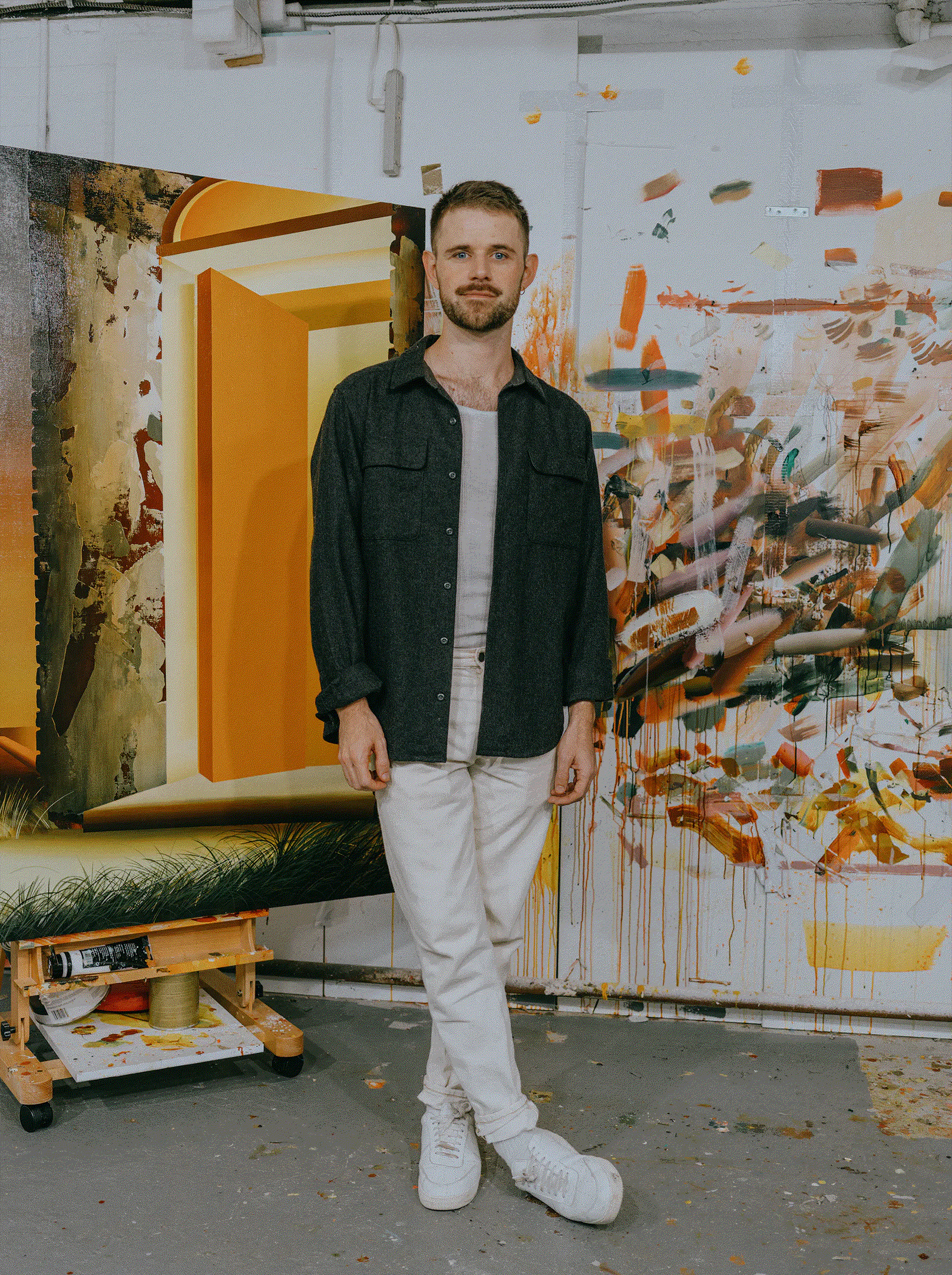
Kyle Dunn in his Brooklyn studio. Photographed by Jack Pierson.
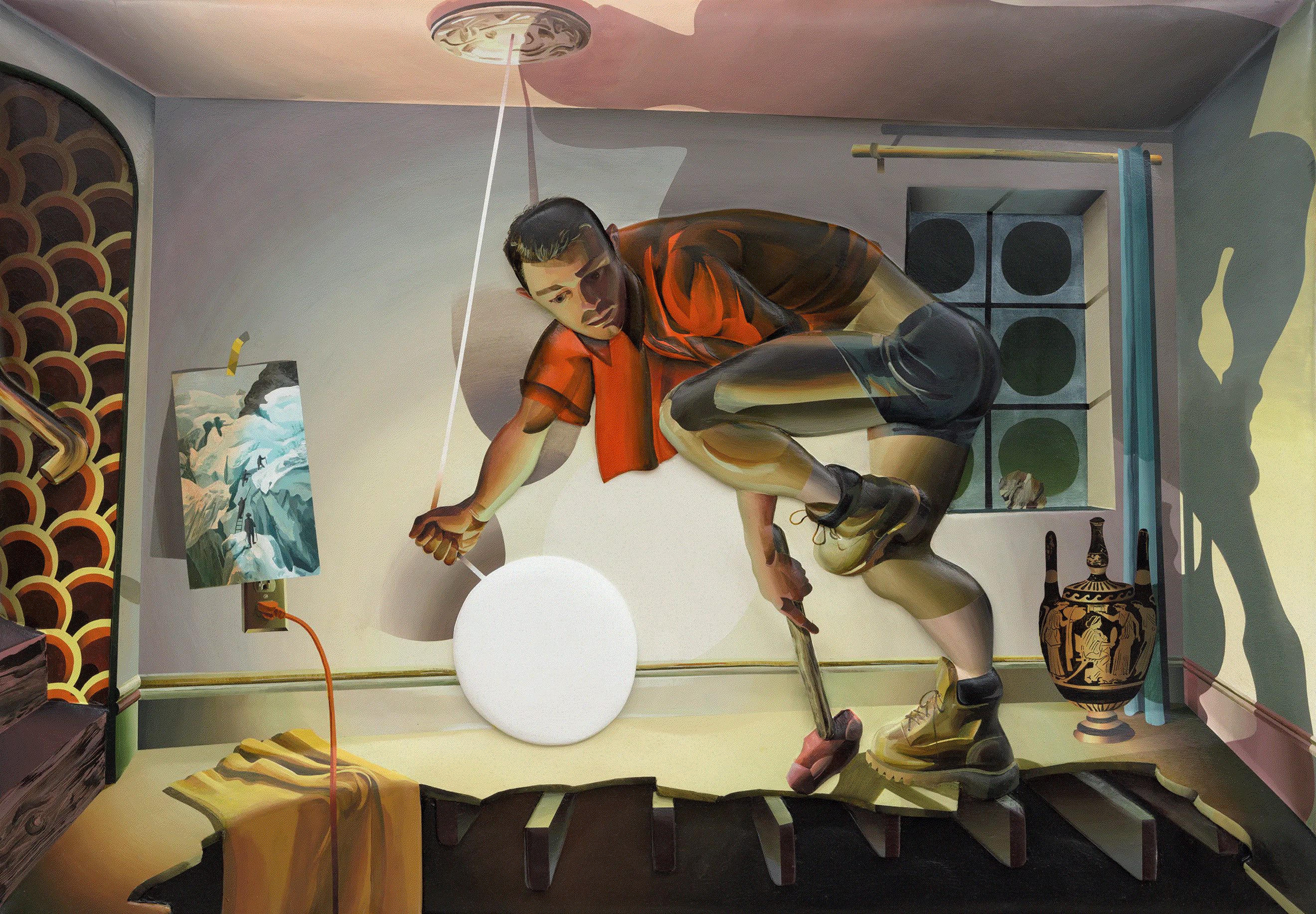
Dunn’s Into the Crevasse, 2019. Courtesy of Kyle Dunn, Galerie Maria Bernheim, Zurich, and PPOW, New York.
Similarly, Wellmann had been in a 10-year relationship with a man in her native Canada. “I was so committed to this idea of hetero life,” she said. “It was so boring.” Even after leaving her partner, she said, she “embedded what I really wanted to talk about. I cloaked it.” She painted porcelain figures of women “as a way of talking about the representation of women’s bodies, a way to think about women’s sexuality without representing it directly.” When she looks at those works now, she said, “I see an intense desire to control experience.” After winning a major Canadian art prize, she moved to Berlin and embraced her anonymity there. “My paintings changed completely, almost overnight,” she said. As in a tale by Ovid, the porcelain bodies metamorphosed into complete, erotically limned women. In a 30-foot-long tour de force that is currently on view in the New Museum Triennial, Wellmann depicted a porcelain drain at the center of a dramatically lit beach populated by swirling, ambiguously defined female forms, alluding to the exit path she had followed.
Langberg, for his part, was painting bottles and landscapes until, as a junior at the Pennsylvania Academy of the Fine Arts, he made graphite drawings based on a sex video he had recorded of himself and a friend in Israel, where he grew up. “My work that I recognize as my own really started with the sexual subject matter,” he said. “The more I allowed myself to paint in accordance with my desires, the better I think my work became, and the better the response was.”
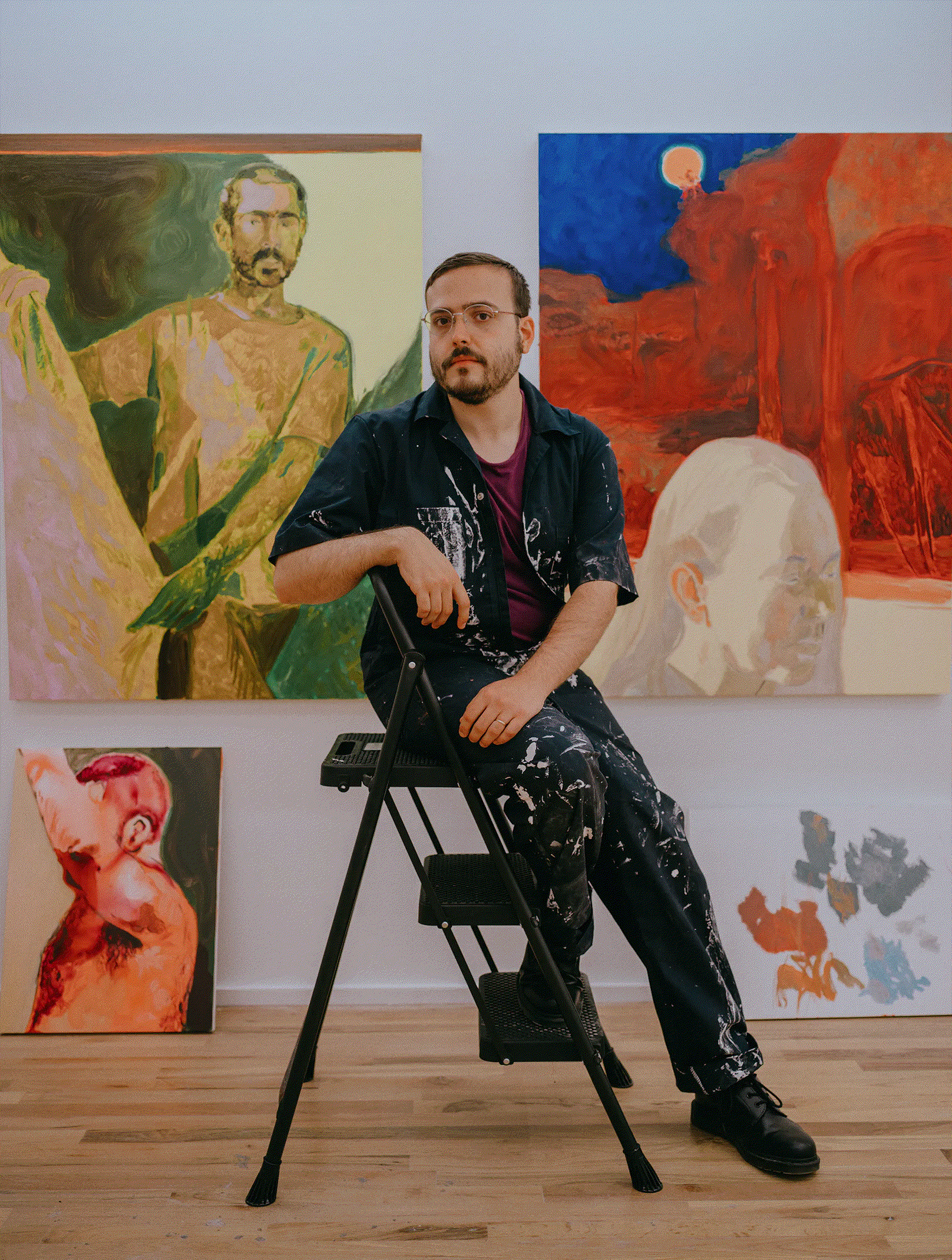
Anthony Cudahy in his studio in Manhattan. Photographed by Jack Pierson.
For Nash Glynn, who is trans, the breakthrough was even more dramatic. Despite having painted self-portraits since childhood, Glynn, 29, abandoned the medium as a student at the School of the Museum of Fine Arts at Tufts University, working instead in video and performance. Things changed after graduation. “I started transitioning, and it was very intuitive to pick up a brush,” she said. “When you grow up without a reflection, sometimes you just need to make your own.” Glynn paints herself in the nude, exposing her breasts and penis. “I’m definitely my own muse,” she said. “Vulnerability is not a weakness; it’s a strength. I also don’t know any other way.” She is intentionally laying claim to a tradition, saying, “I needed to see myself in the history of female nudes in this Western white male tradition, as the creator with a semblance of control.”
Many of these artists have been obsessed with finding a footing in the Western canon. Toor, who was raised in Lahore, Pakistan, studiously copied paintings in museums when he arrived in the U.S., 20 years ago. Enamored of such rococo painters as Pietro Longhi and Antoine Watteau, he adapted their compositions with a more gestural and brushy style, to depict his fellow South Asians. Three or four years ago, he broke away from the constraints of the past by making what he calls “dumb paintings that were not very deep,” representing his gay friends in domestic settings. “Once I became fluent, they just poured out of me,” he said. Those “dumb” works led to his exhibition at the Whitney.

Jenna Gribbon at Fredericks & Freiser gallery, with recent works. Photographed by Tommy Kha.
Housebound during the pandemic, O’Brien stocked up on art books. His latest show featured riffs on the Italian Renaissance masters Michelangelo and Piero della Francesca. “I was very much interested in how we can show gay affection or desire in an art-historical context,” he said. In one painting, he altered Piero’s The Nativity by substituting his husband for the Virgin Mary worshipping the Christ child. “Piero was setting the Bible in his own world,” O’Brien said. “I wanted to be in Brooklyn painting like Piero in Tuscany.” He made another painting from a detail of two hands raised above the water in The Battle of Cascina, one of the few non-homoerotic bits in that unrealized work by Michelangelo of soldiers bathing in a river. But O’Brien isn’t sure he is done with The Battle of Cascina. “I want to do a bathhouse like Spa Castle with this arrangement,” he said.
Ojih Odutola, 36, has invented her own mythology. Born in Nigeria, she immigrated as a child with her family to Alabama. At the Frick, she is preparing a seven-foot-tall portrait of a Nigerian woman to be in dialogue with a Rembrandt self-portrait. It is in the same style as the 40 drawings in her just-opened show at the Hirshhorn Museum and Sculpture Garden, in Washington, D.C., in which she imagines a society where only same-sex relationships are permitted. In subject matter, the Frick drawing is subtler about its queerness. Ojih Odutola said the woman radiates both strength and attentive receptiveness. “She is not fem or masc, but both, in presentation,” she said of her subject. “I feel that way. It’s a queer view.”

Sasha Gordon in her Brooklyn studio. Photographed by Tommy Kha.
The secret history of gay picture-making appeals powerfully to young queer painters. “The Young and Evil,” a show at David Zwirner curated by Jarrett Earnest in 2019, displayed the work of a coterie of interconnected gay New York artists from the 1930s, ’40s, and ’50s: Paul Cadmus, Pavel Tchelitchew, George Platt Lynes, Jared French, and George Tooker chief among them. Much of the work was sexually explicit and could not be exhibited publicly during the artists’ lifetimes. “That show blew my mind,” O’Brien said. Toor concurred: “ ‘The Young and Evil’ was such an important show for all of us,” he said. Finding predecessors can be as confidence boosting as connecting with contemporaries. “There’s nothing new about queer painting,” Glynn said. “What’s new is that we’re capitalizing.”
But sexuality is only part of anyone’s identity. For people of color, ethnicity can be as significant as queerness, and the task is to tie the two together. “Through the paintings and my relationships, I am trying to draw a line between growing up in a conservative Islamic country and being an authentic inheritor of the liberation movements of gay men that happened in the 1970s and ’80s here,” said Toor, who travels from his East Village apartment to visit his family and friends in Lahore every year. “That’s the line I hope to draw that encompasses both of those things: to make them coexist in the world of pictures. The only way they can coexist is in fantasy and allegory.”
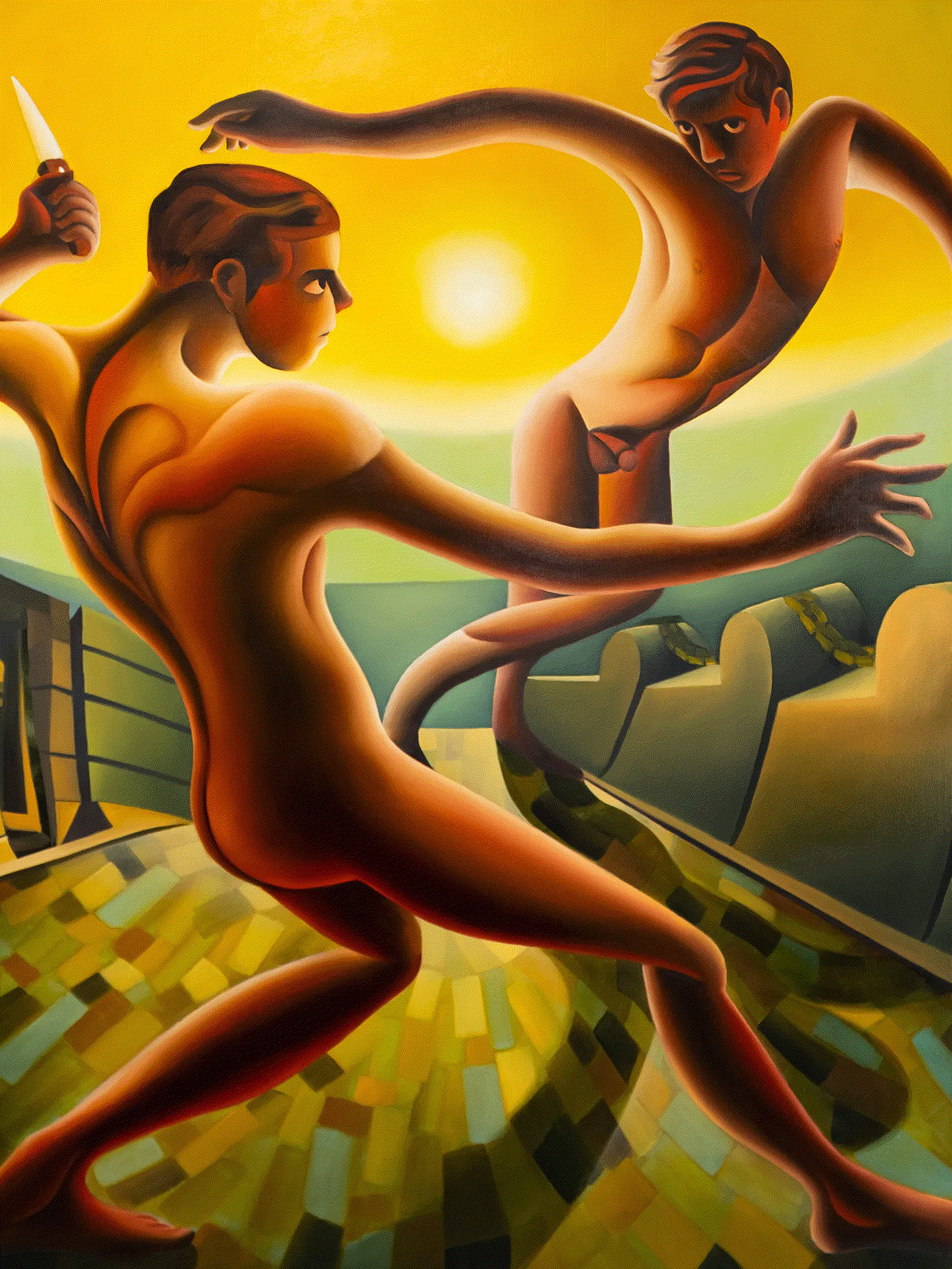
Justin Liam O’Brien, Each Man Kills the Thing He Loves, 2021. Courtesy of the artist and Monya Rowe Gallery, New York.
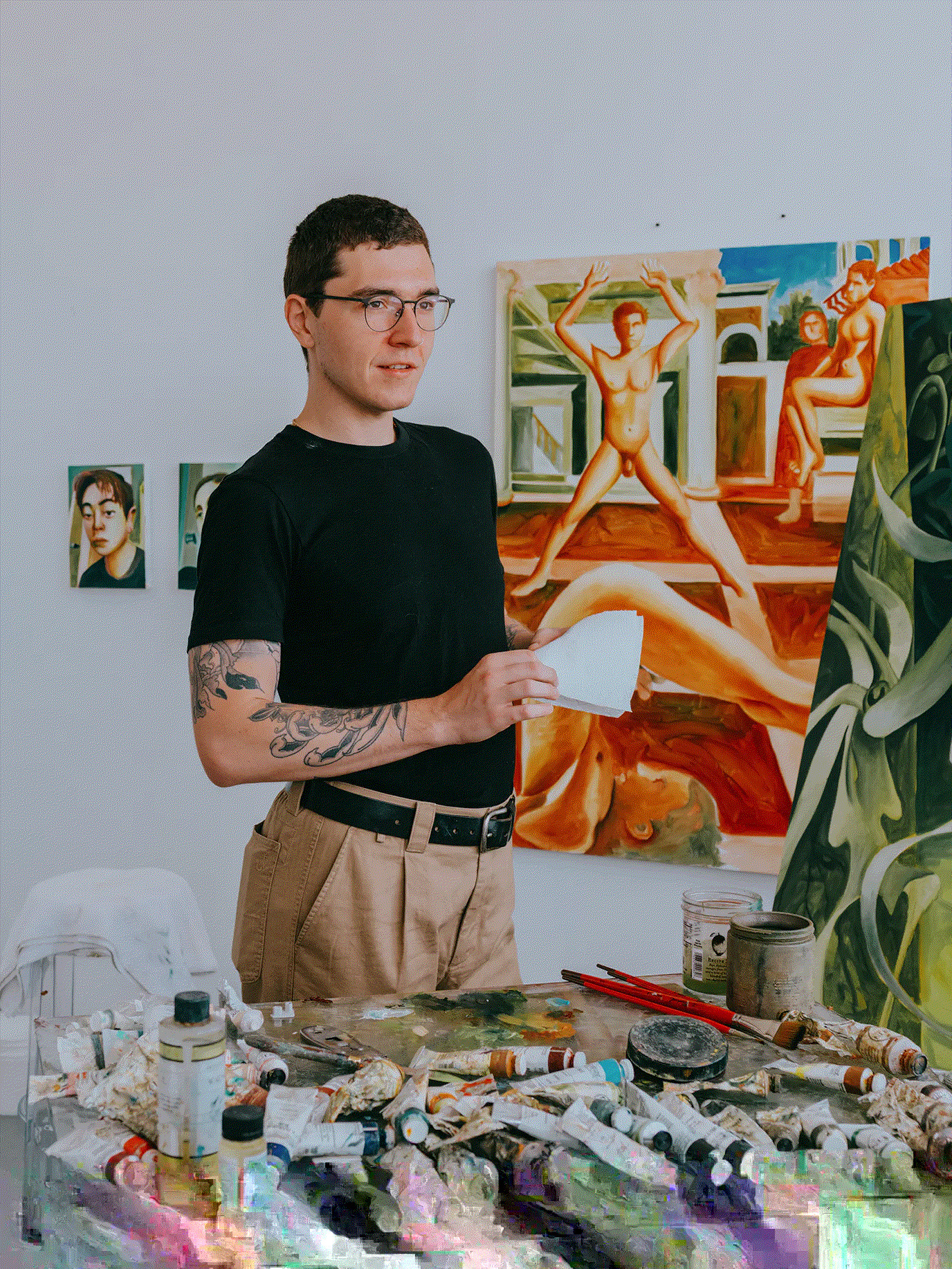
O’Brien in his Brooklyn studio. Photographed by Tommy Kha.
For Sasha Gordon, 23, sexual orientation is the least obvious component of her self-presentation. “I’m Asian and queer, and also in a bigger body,” she said. “It was hard for me to accept that, so I put these three functions together under one umbrella.” Her clearest prototype is the contemporary Chinese artist Yue Minjun, who makes brightly colored pictures peopled by caricatured self-portraits. Gordon does something similar, reimagining scenes from her childhood and inhabiting them with empowered versions (frequently nude) of her current self. “As a minority, you feel wrong to take up space,” she said. “That’s why my paintings are loud, crazy figures that are really chaotic and bizarre. White artists don’t get why seeing this nude body is so important. They felt it was for shock value.”
Ojih Odutola believes the concept of queerness transcends sexuality and challenges the prevailing power dynamic. “I hope my pictures can express the erotic without being explicit, and the pride of the Black body that doesn’t seem like a reaction to its treatment,” she said. “Queerness permeates every picture I make.” She pointed to the skewed perspectives and the patterned mark-making in her recent drawings, and to her use of white and gray chalks and pastels on a black background. “I think it’s a very powerful way of starting,” she said. “How does white operate as a material in that? That’s what I interpret as queering the image.”

Nash Glynn in her Brooklyn studio. Photographed by Jack Pierson.
A queer vantage point is a matter of how you see, not what you see. If these artists make work that challenges assumptions about sex and domesticity, leading in turn to questions about other conventional beliefs, they will be gratified. “When I think about queerness, it’s indefinite,” Ojih Odutola said. “ ‘Queer’ is so open-ended now. You don’t have to identify as LGBTQ to be queer. I think queerness expands our definitions, and makes them more fluid and less striated. There is space for all of us here.”

